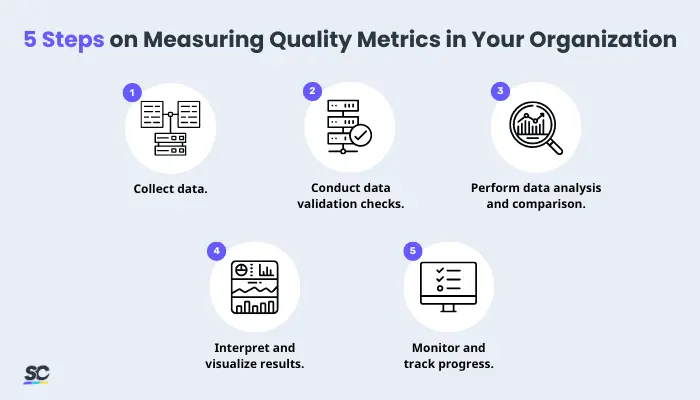What are Quality Metrics?
Quality metrics are quantifiable measures used to assess the performance, effectiveness, and overall quality of a product, process, service, or system. These provide objective data that can help organizations understand how well they are meeting their goals and standards. Quality metrics are crucial in various fields, including manufacturing, healthcare, customer service, and more.
Importance
Quality metrics play a pivotal role in organizations across various industries, serving as a compass and benchmark that guides decision-making, promotes improvement, and ensures the delivery of products and services that meet or exceed established standards. The importance of quality metrics is multifaceted and extends to numerous aspects of business operations and customer satisfaction.
Setting and implementing quality metrics in your organization can help you achieve the following benefits:
- Enhanced Performance Visibility – Employees gain a clearer understanding of their performance and contributions.
- Strategic Alignment – Organizations can ensure that every action taken contributes to big-picture objectives, enhancing overall efficiency and effectiveness.
- Competitive Advantage – A commitment to high-quality products and services, backed by meaningful quality metrics, can differentiate an organization in a competitive marketplace and lead to increased market share and customer loyalty.
- Informed Decision-Making – When employees use metrics to guide their choices, they can expect more favorable outcomes that can be used in weighing which decisions to make.
- Process Optimization – Implementing quality metrics uncovers and addresses inefficiencies or bottlenecks, leading to streamlined processes and improved resource allocation.
- Consistent Quality Improvement – Employees become more proactive in identifying and rectifying issues, contributing to overall quality enhancement.
- Customer Satisfaction and Trust – Consistent quality assurance builds trust and loyalty among customers.
- Employee Engagement and Accountability – When individuals understand how their work contributes to overall quality, they are more engaged, motivated, and accountable for delivering results.
Types
Quality metrics encompass a range of measurements that organizations use to evaluate and ensure the quality of their products, services, processes, and overall operations. Generally, here are the major types of quality metrics you can implement depending on your goals and objectives:
- Outcome Metrics – assess the end result of a process or activity
- Process Metrics – monitor the efficiency and effectiveness of specific processes
- Performance Metrics – evaluate the performance of individuals, teams, or departments in achieving specific goals or targets (e.g., KPIs)
- Compliance Metrics – measure an organization’s adherence to regulations, standards, and guidelines
- Cost Metrics – focus on tracking the financial aspects of quality
- Customer Metrics – center around understanding and meeting customer needs and expectations (e.g., call center Quality Assurance (QA) metrics)
- Employee Metrics – gauge the performance, satisfaction, and engagement of the workforce
- Innovation Metrics – assess an organization’s ability to introduce new ideas, processes, or products
- Supplier Quality Metrics – evaluate the performance of external suppliers and vendors who contribute to an organization’s operations
- Environmental Metrics – measure an organization’s impact on the environment, focusing on sustainability and eco-friendly practices
- Health and Safety Metrics – assess the well-being of employees and the effectiveness of safety protocols
What are Examples of Quality Metrics in Various Industries?
Note that the choice of quality metrics depends on the specific goals and objectives of an organization or project. To give you an overview of how they are applied in certain sectors, here are some common quality metrics examples:
Manufacturing
Quality metrics in manufacturing are used to assess performance and ensure the consistent production of high-quality products.
- Defect Rate
- Overall Equipment Effectiveness (OEE)
- Mean Time to Repair (MTTR)
- Lead Time
- Work-In-Progress (WIP) Inventory
Customer Service
In customer service, quality metrics guide organizations in evaluating the effectiveness of interactions with customers and ensuring a positive customer experience.
- Customer Satisfaction Score (CSAT)
- Net Promoter Score (NPS)
- First Contact Resolution (FCR) Rate
- Average Handling Time (AHT)
- Customer Effort Score (CES)
Healthcare
Quality metrics in healthcare are crucial for gauging the effectiveness, safety, and patient outcomes of medical services and processes.
- Patient Satisfaction Scores
- Length of Stay (LOS)
- Surgical Complication Rate
- Medication Error Rate
- Emergency Department (ED) Throughput
Project Management
Quality metrics in project management help review and assess the performance, progress, and success of projects to ensure that project deliverables meet or exceed defined standards.
- Cost Variance (CV) and Schedule Variance (SV)
- Change Request Rate
- Task Completion Rate
- Earned Value (EV)
- Deliverable Quality
Construction
In the construction industry, quality metrics are vital for ensuring that construction projects meet or exceed established standards, safety, and overall quality of processes and outcomes.
- Cost Overruns
- First-Time Inspection Pass Rate
- Punch List Completion Rate
- Subcontractor Performance
- Contractor and Supplier Performance
Practical Strategies for Implementation
Once employees have gained a foundational understanding of quality metrics and standards, the next crucial step is to integrate this knowledge into their daily tasks and routines.
Implementing quality metrics effectively requires a thoughtful approach that integrates them seamlessly into an organization’s processes and culture. For this, here are some good strategies to consider to ensure their successful implementation:
Metric Selection and Relevance
Ensure that selected quality metrics directly align with the organization’s strategic goals and Key Performance Indicators (KPIs). This provides a clear understanding of how metrics contribute to overall success. Also, clearly define each metric, including its purpose, calculation method, data sources, and desired targets.
Setting Targets and Benchmarks
Train employees on the establishment of realistic and achievable targets or benchmarks for quality metrics. Discuss how these goals can drive performance improvements and motivate teams.
It’s also helpful to determine how often data should be collected for each metric. Some may require real-time monitoring, while others may be measured on a daily, weekly, or monthly basis.
Problem-Solving and Root Cause Analysis
Introduce problem-solving methodologies, such as Root Cause Analysis (RCA), that enable employees to address issues identified through quality metrics. Encourage a proactive approach to tackling underlying problems.
Training and Education
Provide comprehensive training to employees on how to collect, interpret, and use quality metric data. Ensure that they understand the context and relevance of each metric to their roles.
Stakeholder Engagement
Involve key stakeholders, including employees, managers, and leadership, in the process of selecting and defining relevant quality metrics. Their input ensures buy-in and a comprehensive understanding of the metrics’ significance.
Transparency and Communication
Foster a culture of transparency by openly sharing quality metric results, progress, and areas for improvement with all relevant stakeholders. This helps build trust and encourages accountability.
How to Measure Quality Metrics

Steps on Measuring Quality Metrics in Your Organization
Measuring quality metrics warrants a systematic approach to collecting, analyzing, and interpreting data. This way, organizations can effectively measure quality metrics by following these steps:
1. Collect data.
Gather accurate and reliable data from appropriate sources. Make sure to use established data collection methods, such as automated systems, surveys, or manual recording, depending on the metric’s nature. In this step, you can maximize digital checklists, templates, and forms to help you streamline your data collection processes.
Create Your Own Quality Metrics Template
Eliminate manual tasks and streamline your operations.
Get started for FREE2. Conduct data validation checks.
Ensure data accuracy and integrity by implementing validation checks and cleaning processes. Remove outliers, duplicates, or erroneous data that could skew the results.
3. Perform data analysis and comparison.
Apply the defined formula to the collected data to calculate the value of each metric. Analyze the results to understand trends, variations, and potential areas for improvement.
After, compare the calculated metric values to established baselines, benchmarks, or targets. This comparison helps assess performance against predefined standards or goals.
4. Interpret and visualize results.
Interpret the metric results in the context of your organization’s operations and objectives. To help make it easier to understand patterns, anomalies, and trends, you can create visual representations of the metric data using charts, graphs, or dashboards.
5. Monitor and track progress.
Conduct regular reviews of quality metrics to assess their relevance and effectiveness. Make adjustments to the metrics or measurement processes if business goals or conditions change.
Common Challenges and Pitfalls
Implementing quality metrics and maintaining a culture of continuous improvement can be a rewarding endeavor, but it also comes with its share of challenges. Being aware of these challenges can help organizations navigate them effectively.
Watch out for these potential risks and challenges you might encounter:
- Lack of Clear Objectives
- Inappropriate Metric Selection
- Resistance to Change
- Lack of Leadership Support
- Misalignment with Culture
- Inconsistent Implementation
- Lack of Training and Education
- Short-Term Focus
- Benchmarking Without Context
- Lack of Continuous Review
Designing an Effective Quality Metrics Training Program
In today’s competitive business landscape, maintaining high standards of quality is paramount for success. A well-designed training program that educates employees about quality metrics and standards can significantly contribute to the improvement of products, services, and overall operational excellence.
You can follow these steps to create a comprehensive training initiative on quality metrics:
- Create engaging and informative training content that covers the fundamentals of quality metrics, their significance, and their role in achieving organizational goals.
- Incorporate interactive workshops, case studies, and hands-on activities to reinforce learning.
- Collaborate with Subject Matter Experts (SMEs) within the organization to ensure accurate and relevant content.
- Implement assessment tools to measure participants’ understanding and application of quality metrics concepts.
- Tailor the training program to the specific needs of different departments or teams.
- Integrate real-life examples and case studies that showcase the positive impact of using quality metrics and standards.
- Prioritize effective communication and engagement throughout the training program.
- Collect feedback from participants and make necessary adjustments to optimize the training experience.
To help you improve your training initiatives, you can maximize the power of technology in optimizing the overall learning experience of your employees. Using SafetyCulture (formerly iAuditor)’s Training solution, you can:
- deliver bite-sized or comprehensive training courses targeted to various teams and their respective roles in implementing quality metrics;
- monitor milestones on completed quality management lessons; and
- constantly improve learning initiatives to ensure alignment with quality metrics across the organization.
FAQs About Quality Metrics
Quality Assurance (QA) is a comprehensive approach aimed at preventing defects and ensuring consistent quality through established processes and standards. Quality metrics, on the other hand, are tools used to measure and analyze various quality-related aspects to gain insights, make informed decisions, and drive continuous improvement efforts.
KPIs are broader performance indicators that gauge an organization’s overall progress toward strategic goals. In contrast, quality metrics are specific measurements used to assess, analyze, and improve the quality of products, processes, or services.
The frequency of measuring quality metrics depends on the nature of the metric and the goals of the organization. Some metrics may be measured daily, while others are assessed on a weekly, monthly, or even yearly basis. That said, it’s best to brainstorm and conduct practical tests on how frequently you must monitor and measure your quality metrics.
Yes, quality metrics are often used for benchmarking purposes. By comparing their quality metrics to industry standards or best practices, organizations can gain insights into their relative performance and identify areas where they can excel or need improvement.




